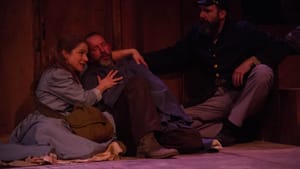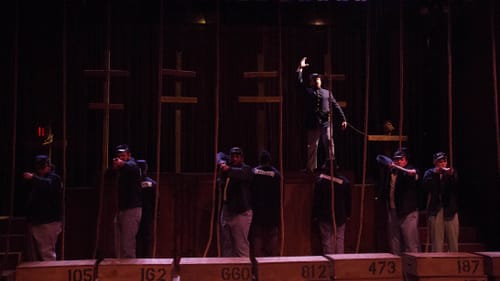Stay in the Loop
BSR publishes on a weekly schedule, with an email newsletter every Wednesday and Thursday morning. There’s no paywall, and subscribing is always free.
Pioneer woman
EgoPo Classic Theater presents John Guare's 'Lydie Breeze Part 1: Cold Harbor'

You must walk through hell to reach utopia. A heroine’s journey through the swirling underbelly of the American Civil War comprises much of Cold Harbor, the often brilliant and occasionally maddening first entry in John Guare’s Lydie Breeze trilogy. Lane Savadove’s visually arresting production for EgoPo Classic Theater highlights perhaps the most interesting aspect of Guare’s project: how storytelling itself shapes the past and future.
Making myths
Cold Harbor shares stylistic and thematic elements with A Few Stout Individuals and A Free Man of Color, Guare’s previous reckonings with American history. (Although Lydie Breeze predates both plays, it was significantly rewritten and restructured for this staging). But unlike those works, Guare doesn’t present a sustained narrative here. Instead, he fuses music, dance, fairytale, and magic realism to describe the unspeakable carnage of war and the transcendental ideals that sprung from it.
Such a discursive approach can be puzzling. I sometimes wondered whether Guare chose these alterations firmly in service to his story, which has clear points to make despite its lack of cohesion.
The title character (played by Melanie Julian) emerges as a self-actualized woman, buoyed by a quest to answer the lingering questions haunting her family. Guare presents her as a chronicler of herself and her time, the US Civil War; she consciously records the events of her life in an ever-present journal. Midway through its long first act, the play pivots from earnestly recounting the Battle of Cold Harbor to a deliberately performative mythmaking session between Lydie and her three male companions, Joshua (Charlie DelMarcelle), Amos (Ed Swidey), and Dan (David Girard).
Here, Savadove’s extraordinary directorial instincts realize what even Guare doesn’t fully express. The sheer theatricality of Savadove’s concept compensates for deficits in Guare’s writing. Many plot points are introduced and abandoned; whether these narrative strands will connect in the further plays remains to be seen, but when viewing Cold Harbor as a standalone work, it becomes frustrating.

Careful and stunning
Working with composers Jay Ansill and Cynthia Hopkins, Savadove flavors the diegetic and interstitial music with authentic echoes of American folk and country ballads. Several talented ensemble members do yeoman’s work as onstage musicians, playing with spectacular verve.
Markéta Fantová’s wooden fortress of a set effectively conveys multiple locations, from battlefield to steamer ship. Mike Inwood’s breathtakingly cinematic lighting conjures the horrors and splendors of the central quartet’s journey from ravaged Virginia to idyllic Nantucket, where they will aim to build a natural, self-sustained paradise. Marie Anne Chiment supplies realistic period dress for the main characters and evocative costumes for the supernatural beings that populate the play, which include a bruised buzzard god and a frighteningly loquacious pig.
The presence of the mystical creatures is never fully justified by the text, although they make dramatic sense in performance as vestiges of Lydie’s brilliant, battered mind. Certain characters — a perennially agitated army captain, a crazed Confederate widow who seems a cross between Madame Thenardier and Minnie Pearl — exist only for unnecessary comic relief.
But Savadove never eclipses the play’s central message. Lydie sets out to become the mistress of her fate, and as Cold Harbor progresses to its stunning final tableau, we understand how she has consciously constructed her identity. Although Julian’s performance can be relentlessly monochromatic, we never lose sight of Lydie’s trailblazing spirit, and I look forward to delving deeper into her psyche as the trilogy unfolds.
Cold Harbor ends on the promise of a perfect society rising from the war’s dust. History has shown how problematic such a premise can be, but in the hands of Guare, Savadove, and perhaps the most impressive ensemble currently treading Philadelphia’s boards, we are ready to follow them into the unknown.
What, When, Where
Lydie Breeze, Part I: Cold Harbor. By John Guare, Lane Savadove directed. EgoPo Classic Theater. Through February 11, 2018, at the Christ Church Neighborhood House, 20 N. American Street, Philadelphia. (267) 273-1414 or egopo.org.
Sign up for our newsletter
All of the week's new articles, all in one place. Sign up for the free weekly BSR newsletters, and don't miss a conversation.

 Cameron Kelsall
Cameron Kelsall